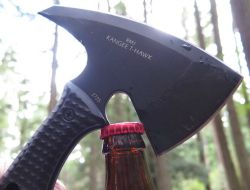
If ever there was a tool today in search of a purpose, the survival tomahawk is it. With its primal shape and apparent infinite number of uses, the tomahawk, you would think, should be part of all kits from barbecue to bug out. Alas, the tomahawk and its tactical siblings are the bane of our survival imagination. They show up at all the photoshoots, decorate Pinterest EDC posts, and are made by nearly every knife company whether reputable or not. But still, what good are they?
By Doc Montana, a contributing author
History is for Sissies
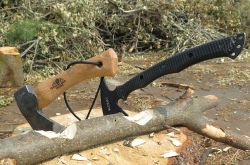
According to the Gransfors Bruks website, the origin of the word tomahawk is from the Lenape tribe use of the word tomahawk, which loosely translates to “cutting tool.” Although the tomahawk has a rich past, so does the sling, the atlatl, the spear and even the horse. So why has there been an explosive resurgence in the availability of tomahawks to the point that even Home Depot and Target have a section of hawks to choose from? Heck, even Walmart has 125 hits on their website for the search term “tomahawk” with a serious dose of the hits being actual metal bladed tomahawks and not toys or sports memorabilia.
I have talked to some service boys who found a use for the tactical tomahawk in the unstable hot deserts of the world. Their uses included puncturing 55 gallon drums to both drain their contents and create burn barrels. And with spiked hawk instead of hammer, the tomahawk will puncture tires better than just about anything else. Of course there is also the hand-to-hand fighting aspects which the hawk excels. Unfortunately, none of those tasks are on my shortlist of needs when it comes to an edged tool. What is on my list for a hawk? Well, that it yet to be determined.
CRKT TacHawk
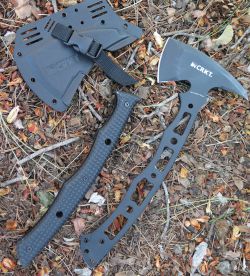
The tomahawk, or just hawk for those a little cooler, has many uses, but few skills better than any of the special purpose tools it would replace. Well, except for one. The tactical hawk is usually tougher than pretty much anything else in your kit. The hawk…make that a quality hawk… is a survivor that does its job harder and longer than anything else you can carry. On the gentle end the hawk can slice and carve and gut. On the more forceful end, the hawk can chop and slash and pound. But then there is the over-the-top end where the hawk can breach, demolish, kill, and fly through the air on its way to the job site. The hawk can open a car door, or simply go right through it splaying the tin like a can opener. The hawk can puncture tires, cut out a windshield, even disable an engine. But none of that matters in the wilderness or when doing bushcraft. So therein lies the dividing line between the dedicated tool (knife, hatchet, axe, machete, etc.) and the tomahawk.
For me, the hawk is more of an urban tool. Remember, I said for me. I absolutely love addressing large wood challenges with my Gransfors Bruks hatchets and axes. I love carving with Spyderco and Benchmade bushcrafting blades. And if I need a hammer or pick I will use my hammer or pick. I even have some specialty tools I carry in the truck including the Crovel Elite. But I cannot deny the Hawk urge when I need a grab-and-go tool for all the unknowns and many of the knowns. Apparently the hawk comes in second in enough races to win overall.
Tomahawk Use: Violent Encounter
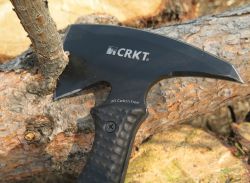
A good hawk is a brute force instrument that can be beat hard against anything. Its résumé includes being thrown fast whether across the room or at the nearest outdoor recipient in need of a good puncture. The hawk as a prybar exceeds that of almost every other tool except a pry bar. The wood chopping capabilities of the hawk are second only to the axe, and perhaps on par with your hatchet. A hawk’s brush clearing talents loose to machetes but win over knives. And if your brush leans towards branches, then the hawk wins.
But all the useful violence packed into the hawk is not without its downfalls. One of the most common issues with a real hawk is the fact that you are swinging a relatively sharp blade attached to a generally short handle. As any hatchet user knows, the closer the moving edge, the more danger one is in. Making matter worse is that instead of just a flat poll like on a traditional axe, many tachawks have an evil looking spike watching its six. With sharp flying in two direction, the tactical tomahawk is a not a great tool for those with self-inflicting tendencies.
Lizzie Borden might have found success with the axe as a defensive tool- well offensive really, but the hawk’s track record for protecting its user goes far beyond the traditional tools you’d find in the woodshed. So this particular situation begs the question of should your hawk be a defensive tool you carry that just might have some practical use as well? Interesting question.
Test Drive
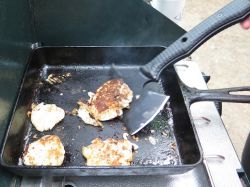
After carrying around a tactical hawk, the CRKT Kangee to be exact, along with an assortment of larger fixed blades and smaller hatchets, I’ve learned a few things. First, the CRKT hawk is a great tool for what it does well. But what it does well is a pretty small subset of the tool tasks I do daily or even plan on ever needing in the future.
The CRKT Kangee arrived to me through the hands of an actual Native American fellow; a Blackfeet to be specific. I found that an interesting twist in this tomahawk introspection. But I digress. In essence the hawk now in my hands is a pretty good design, and one that I will use as representative for this particular edged breed. The hundred dollar price tag is not inconsequential, and the $185 retail and second generation version with an orange handle tells me that CRKT thinks they are on to something. And buyers seem to think so as well. So why am I having so much trouble finding a home for this wonderful piece of hardware in my kit? Simple. It all comes down to the survival scenario.
In my particular old west scenario, I first make the decision to bug in or bug out. If “in” I have all my usual tools with prejudice for the right tool for the job. If I choose to bug out, I am limited in my portable carry until I either reach a designated BO location, or begin the “run.” No matter what, I need the right tools for the purpose, not a cool idea that is half-baked or past its prime.
As a hatchet, the CRKT Kangee has a decent head, but a handle with a little too much curve for basic field woodwork. The bit or cutting edge is also not quite right for chopping wood because of its uniform flat profile and its rounded blade presentation. The blade sticks into the wood grain like a knife blade and holds on. Anything outside angled hits risk getting stuck in the wound requiring about as much effort to remove as it did to put it there in the first place. But for big chopping in softer wood, the Kangee does get the job done remarkably well.
The Katrina Tool
Playing on the theme of the Katrina Rifle, and using the hindsight of the 10th anniversary of Hurricane Katrina and the Charlie Foxtrot that followed, I would venture that a tomahawk such as the Kangee might be at the top of my short list of tools when it really is grab-and-go time.
Normally I’d lean towards the a more focused tool, but Katrina or whatever S happens to HTF require a more diverse understanding of the tasks that lie ahead. Any hand tool worthy of its weight in a forced bug out must serve equally as a weapon as a breacher as a wood processor as a survival blade. Using the Katrina event as a model, all of the above jobs were needed at one point or another to save lives. As a weapon was a no brainer, but a breacher?
Yes. More than a few fine citizens of the Crescent City found themselves cornered by water to the south (down) and a hard place to the north (up). Unless it was possible to chop through a ceiling or house roof, the end was both ugly and near. If all you got is a Gerber LMF, you are ahead of the curve, but not by enough. Fighting your way through a wall or wooden roof with a survival blade is possible, but with the tide rising, you might not make it in time.
On the other hand, if you try to scare off the marauders with a shovel, then good luck to you. Have you ever thrown a shovel at someone? It’s little more than a cute effort by a mouse cornered by a mountain lion. A tomahawk, on the other hand, is a throwing weapon that becomes deadly with even mild skill. But then again, you better be sure of yourself when you throw your weapon at your enemy.
So I have come to the conclusion that the tactical tomahawk might be the last tool you need but the first one to grab. I know that might sound like a contradiction, but then so does TEOTWAWKI. And if you add the letters WROL to the pile, the Kangee will not just be my first choice, but my only choice. Got a use for the survival tomahawk? Tell us about in the comments below.
All Photos By Doc Montana

28 comments
I bought a cold steel rifle mens hawk maybe 12 or 13 years ago I have used it for chopping would splitting wood clearing brush and every other dirty job that can thought of I still have it right now and it still is just as good as when I bought it
One very important thing to keep in mind is that in certain states, such as Texas where I live, hawks are illegal weapons in public. Keep them on private property only.
Seriously? Lucky I got out of Texas last time I was there instead of rotting in a jail cell because I stepped over a line I never imagined could exist outside of NYC and D C.
So how do you buy a hawk in Texas?
he didn’t say you couldn’t buy one.
it could be worse…
I can’t carry a pocket knife in Philly, if it has a locking blade.
I was in Phili last month for a trade show and walked around for 3 days with a 3.7″ locking folder in my back pocket with the pocket clip exposed the whole time !! I had no idea I had a legal liability. Glad I didn’t find out while I was there ( ie get stopped by a Cop).
Got a sog fasthawk a few years ago and no issues.
Got the CRKT Kangee T hawk myself. Haven’t given it any hard usage though. It’s very well built. Sheath is nice. The head is a little small in my opinion. The spike could be a little longer too. The Handel had a forward curve to it which lends itself to a chopping motion for the sharp edge. It makes for a little awkward swings when trying to impact with the pointed edge of the head.
It is wicked sharp right from the box. The handle lends itself for choking up on your grip for close work. I was able to put a sharp edge across the top edge of the head of the hawk. Factory has a dull grind across said top edge. With a file and a stone I was able to make the top edge of the head razor sharp as well.
My use for the hawk is backup to my HD firearm. If I can’t get the safe open/ fast enough the hawk sits close by. I feel it lends itself to simple defense usage in close quarters. It would be quite formidable in determined hands.
PS the tomahawk is a weapon that could be pushed I to tool type usage. Not the other way around. If your thinking about chopping / camp work you will be better suited by a quality Ax. Gerber makes great camp ax for a fair price.
Love the Kangee. I’ve been carrying a large bowie and a hawk for over 30 years, laws be damned. I have dozens of hawks. Traditional styles and modern, all the popular brands, and quite a few hand made pieces. I’ve won throwing contests at Rendezvous’ and consider the tomahawk a necessity every day. The Kangee is about the most useful overall design. Love it!
Thanks for the read DH.
So what do you use your hawk for? And speaking of laws, no details but the article was written during travel through five states and two countries. Guess I should count my blessings.
Oh, and the hawk won’t open a beer unless used as a hammer.
I really only have use for it when I’m in the woods. But occasionally I’ll need to open a shipping container or break a lock (for my job).
Using a hawk to break a lock on a shipping container?
I gotta hear more…
No locking blades in Philly? Where did you learn that one? I’ve read the PA knife statutes, but don’t remember seeing that one.
Here’s the statute which applies in Philadelphia: https://www.phila.gov/philacode/html/_data/title10/chapter_10_800_safety/10_820_Cutting_Weapons_in_Publ.html
Basically, nothing is legal.
I couldn’t do the time, so I rarely commit the infraction.
I work on a federal job site, too. so basically, the Constitution doesn’t protect me either…
but at least, my life insurance is paid up.
So if I order a steak do they cut it for me in the kitchen or do I get a plastic spork and knife?
they would make you settle for TOFU, if they thought they could…
Wow no “cutting weapons”
In Philadelphia must be the start of another communist state like the people’s republic of California/New York city..
Let’s see… thugs are stabbing people with box cutters so let’s ban boxes so no one needs a box cutter!! In Ohio you can carry any blade at any age except on schools and churches, except our pastor has said if you have a ccw you may carry as long as you don’t mention anything about it
Switch blades and the like are illegal to have in public “hidden from common observation” blades over 6″ are considered dangerous ordnance like a switch blade.
I can imagine tomahawk being illegal to have hidden but then again why do you need it hidden? Unless you’re a criminal? The sog tomahawk I have is well balanced unlike the larger ones.
statewide, we can’t have a dagger…
but I believe there is a “hunting knife” exception.
I bought mine online at the Crkt website
I have a schrade scaxe3
I have used it several times for splitting wood on camping trips, and once used it as a shovel to dig a small drain ditch on a rainy camping trip (camping in Florida this can happen often)
the handle is a good length for chopping one handed, and gives a good bit of power behind the swing. the spike end also proved good for splitting oak and pine.
the sheath sucks horribly though. I had to modify it with a few rivets, cutting some of the stitching, and add a quick release clip for retention.
I wish I had better skills with kydex, as I would make a better way to carry it.
I still think I am going to drill a lanyard hole at the bottom, and I may wrap the handle with cord to give a better grip.
https://www.amazon.com/Schrade-SCAXE3-Tactical-Stainless-Sheath/dp/B00BO2ESWE/ref=sr_1_10?ie=UTF8&qid=1443278289&sr=8-10&keywords=schrade+scaxe
There is a kid on YouTube that makes sheaths using plastic Milk jugs. Looks really easy. Just do a search milk jug sheath.
4 years ago I managed to acquire both a SOG tomahawk and a Ko-Katana (wakishahi length blade with two handed Katana grip.)
Decided to try them both out by hacking up the Blue Spruce Christmas tree a week or so later.
I was amazed at how much a fancy tact-cool SOG brand tomahawk could suck at chopping up a 7 foot Christmas tree , Its still an axe why is it so lame?
Comparatively the Ko-Katana was a FAR more effective umm….. tool for hacking limbs off. (Leave it to the Japanese to know about hacking off limbs)
So the tomahawk went up for sale on ebay and the katana has a place on honor on the wife’s side of the bed (since she is japanese and has a few years of kendo under her belt)
We now live in big timber country and I split a lot of wood for heat. about 3 chords per winter. I use the Fiskers X27 for most of my work, Its their heaviest longest model since I’m 6’3″. I even split my kindling with this item by choking up my grip until this year when I bought the matching Fiskers splitting Axe. If you’ve never tried them these splitting tools from Fiskers are superior to every maul I ‘ve tried.
i also have a pair of Eastwing axes ;the 3/4 length camp axe, and the matching blue handle hatchet. These are very durable with the head and shaft all one piece of forged steel, but not as efficient as the Fiskers at splitting wood for a stove, but better at chopping something down. However I’ve found that a saw is more efficient to fell trees and cut pieces to useful length. Recently I acquired a 12″ brush cutting blade for my Ryobi cordless 18V reciprocating saw and have found that has become my one tool i grab for all manner of dealing with wood cutting/clearing from light brush clearing on the back of our property up to limbs and standing trees to about 8″ diameter.
instead of a pruning shears and chainsaw I find this one tool is doing most chores. i carry a few batteries in a Homer Bucket with me along with anything else I might need and manage to work until I’m tired and hungry with just this Ryobi. So What would I need a cutting axe for again?
Hawk in the woods…..
As a scout in my younger years and into my late twentys when I went backpacking I would carry a hawk instead of a Axe. They are lighter and work well on small logs and kindling. For lager items I would use a cable saw. Remember I said backpacking so I was trying to keep it light. We made our own Hawks
and ours had hickory handles that would have a flat striking head on the opposite of the cutting head.
This was handy for driving in tent stakes.
Yes I could throw it and make it stick.
If I need an axe, I go with Estwing. If I am going to be attacked with a tomahawk, I go with S&W .357. I am 63 and way to old to be grappling it out with tomahawks. Ask yourself, do you really want to get into a battle with a tomahawk. If you have never seen what a gash an axe can make on your body, then take a roast or side of beef and hit it with an axe. Then ask yourself if this is the kind of fight you are looking for. Stay prepared my friends.
great reply Sir!
Along the lines of don’t bring a knife to a gunfight.
There are better edged weapons than a tomahawk, let alone all manner of firearms. and there ate better chopping and cutting tools than a tomahawk for similar weight and size.
So this article seems a bit light on usable substance.
The Camping/Scouting reference above about having one tool which functions as a hammer and for chopping seems to be the only redeeming feature, but many “tacti-cool” tomahawks have a pointy backside with eliminates this functionality.
I’ve seen spec ops guys with Kukri Gurkha knives when they were heading to the jungles. The Kukri Seems a better way to allocate 2 lbs of mass to your carry load if you need such an item.
Around the homestead, I’ve already debunked the “hawk”.
So with your “.357” comment above, I think we’ve killed the topic. Like you mention, No even in my younger years I would not want to get in a gruesome axe fight, which is why I owned a 12 gauge long before an axe. Well done.
à ¤°à ¤¾à ¤œà ¤®à ¤§à ¥‡ à ¤Âà ¤• à ¤µà ¥‡à ¤—à ¤³à ¤¾à ¤š à ¤†à ¤•à ¥Âà ¤°à ¤®à ¤• à ¤ªà ¤£à ¤¾ à ¤†à ¤¹à ¥‡. à ¤†à ¤£à ¤¿ à ¤¤à ¥Âà ¤¯à ¤¾à ¤š à ¤®à ¥Âà ¤³à ¥‡ à ¤¤à ¤°à ¥Âà ¤£ à ¤†à ¤•à ¥ƒà ¤·à ¥Âà ¤Ÿ à ¤Âà ¤¾à ¤²à ¤¾à ¤¯ à ¤®à ¤¨à ¤¸à ¥‡ à ¤•à ¤¡à ¥‡. à ¥ ¶Ã ¤¿Ã¤µà ¤¸à ¥‡à ¤¨à ¤‡à ¤®à ¤§à ¥‡ à ¤¤à ¥‹à ¤š à ¤®à ¤¿à ¤¸à ¤¿à ¤‚à ¤— à ¤†à ¤¹à ¥‡. à ¤†à ¤¯à ¤¬à ¥€à ¤Âà ¤¨ à ¤²à ¥‹à ¤•à ¤®à ¤¤ à ¤²à ¤¾ à ¤¦à ¤¿à ¤²à ¥‡à ¤²à ¥€ à ¤®à ¥Âà ¤²à ¤¾à ¤–à ¤¤ à ¤®à ¥Âà ¤¹à ¤£à ¤œà ¥‡ à ¤ªà ¤¹à ¤¿à ¤²à ¥€ à ¤¸à ¥‡à ¤¨à ¥Âà ¤¸à ¤¿à ¤¬à ¤² à ¤®à ¥Âà ¤²à ¤¾à ¤–à ¤¤ à ¤†à ¤¹à ¥‡ à ¤°à ¤¾à ¤œ à ¤šà ¥€.à ¤¯à ¤¾ à ¤Âà ¤¾à ¤·à ¤£à ¤¾à ¤®à ¤§à ¥‡ à ¤¤à ¥Âà ¤¯à ¤¾à ¤¨à ¥‡ à ¤¬à ¤°à ¤¾à ¤š à ¤¸à ¤®à ¤¤à ¥‹à ¤² à ¤¸à ¤¾à ¤§à ¤²à ¤¾ à ¤†à ¤¹à ¥‡, à ¤†à ¤£à ¤¿ à ¤µà ¥ˆà ¤šà ¤¾à ¤°à ¤¿à ¤• à ¤¦à ¥ƒà ¤·à ¥Âà ¤Ÿà ¥Âà ¤¯à ¤¾ à ¤ªà ¤£ à ¤ªà ¤°à ¤¿à ¤ªà ¤•à ¥Âà ¤µ à ¤µà ¤¾à ¤Ÿà ¤¤à ¤‚ à ¤¤à ¥‡ à ¤Âà ¤¾à ¤·à ¤£.. à ¤†à ¤§à ¤¿à ¤šà ¥Âà ¤¯à ¤¾ à ¤®à ¥Âà ¤²à ¤¾à ¤–à ¤¤à ¥€ à ¤†à ¤£à ¤¿ à ¤Âà ¤¾à ¤·à ¤£à ¤‚ à ¤®à ¤²à ¤¾ à ¤…à ¤œà ¤¿à ¤¬à ¤¾à ¤¤ à ¤†à ¤µà ¤¡à ¤²à ¥€ à ¤¨à ¤¾à ¤¹à ¤¿à ¤¤.
I told my grandmother how you helped. She said, “bake them a cake!”